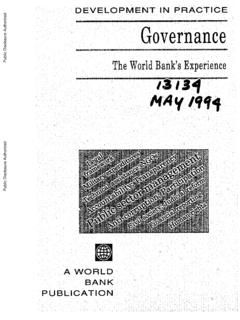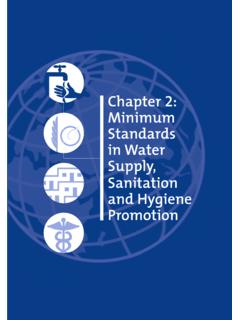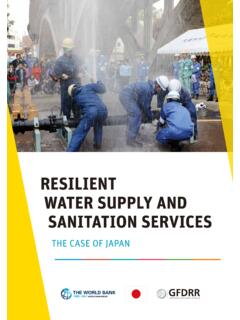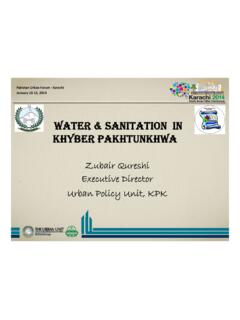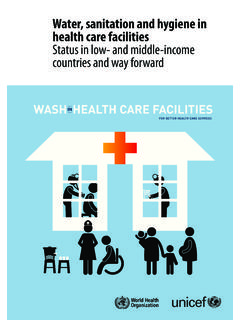Transcription of Water Supply and Sanitation in Lao PDR - The World Bank
1 Water Supply and Sanitation in Lao PDRT urning Finance into Services for the FutureNovember 2014 Service Delivery AssessmentPublic Disclosure AuthorizedPublic Disclosure AuthorizedPublic Disclosure AuthorizedPublic Disclosure AuthorizedThis report is the product of extensive collaboration and information sharing between many government agencies at national and provincial level as well as development partners. A core team drawn from the Ministry of Health (Department of Hygiene and Health Promotion, Department of Planning and Finance, National Center for Environmental Health and Water Supply ) and Ministry of Public Works and Transport (Department of Housing and Urban Planning, Department of Finance, Water Supply Regulatory Office) have been key partners with the Water and Sanitation Program (WSP) in analyzing the sector. The authors acknowledge the valuable contributions made by Department of Planning and Investment, Ministry of Planning and Investment, WHO, UNICEF, Plan International, JICA, UN-Habitat, SNV, AFD, Lao Red Cross, Care International in Lao PDR, Health Poverty Action, Helvetas, Nam Theun 2, CAWST, Child Fund and World Task Team Leader for the Service Delivery Assessment in East Asia and Pacific is Susanna Smets.
2 The following World Bank staff and consultants have provided valuable contributions to the service delivery assessment process and report: Jeremy Colin, Sandra Giltner, Viengsamay Vongkhamsao, Bounthavong Sourisak, Viengsompasong Inthavong, Almud Weitz and WSP support following World Bank staff and sector colleagues peer reviewed the report: William Rex, Lead Water Resources Spe-cialist, Ingo Wiederhofer, Senior Operations Officer, Thea Bongertman, WASH Sector Leader, SNV Lao PDR, and John Mc-Gown, Sr. WASH Advisor Plan International, Lao s Scaling Up Rural Sanitation is working with governments and the local private sector to develop the knowledge needed to scale up rural Sanitation for the poor. The programmatic approach combines Community-Led Total Sanitation (CLTS), be-havior change communication, and Sanitation marketing to generate Sanitation demand and build up the Supply of Sanitation products and services at scale. In addition, WSP works with local and national governments and the local private sector to strengthen the enabling environment including institutional, regulatory, financial, service-delivery, and monitoring capacities to achieve change that is sustainable.
3 Starting in India, Indonesia, and Tanzania in 2006, Scaling Up Rural Sanitation is currently being implemented in more than a dozen countries. For more information, please visit Working Paper is one in a series of knowledge products designed to showcase project findings, assessments, and les-sons learned in the Global Scaling Up Sanitation Project. This paper is conceived as a work in progress to encourage the exchange of ideas about development issues. For more information please email or visit Water and Sanitation Program is a multi-donor partnership, part of the World Bank Group s Water Global Practice, sup-porting poor people in obtaining affordable, safe, and sustainable access to Water and Sanitation services. WSP s donors include Australia, Austria, Denmark, Finland, France, the Bill & Melinda Gates Foundation, Luxembourg, Netherlands, Nor-way, Sweden, Switzerland, United Kingdom, United States, and the World reports are published to communicate the results of WSP s work to the development community.
4 Some sources cited may be informal documents that are not readily findings, interpretations, and conclusions expressed herein are entirely those of the author and should not be attributed to the World Bank or its affiliated organizations, or to members of the Board of Executive Directors of the World Bank or the governments they represent. The World Bank does not guarantee the accuracy of the data included in this work. The bound-aries, colors, denominations, and other information shown on any map in this work do not imply any judgment on the part of the World Bank Group concerning the legal status of any territory or the endorsement or acceptance of such material in this publication is copyrighted. Requests for permission to reproduce portions of it should be sent to WSP encourages the dissemination of its work and will normally grant permission promptly. For more information, please visit 2015 International Bank for Reconstruction and Development / The World BankWater Supply and Sanitation in Lao PDRT urning Finance into Services for the FutureWater Supply and Sanitation in Lao PDRivLao PDR has met the Millennium Development Goal (MDG) targets for both Water Supply and Sanitation according to UNICEF/WHO Joint Monitoring Programme (JMP).
5 How-ever, national access remains low compared to other coun-tries in the region and today there are still million people without access to improved Water Supply and million without access to improved The problem is es-pecially acute in rural areas, with large inequalities in access between areas that are close to good roads and remote, inaccessible Government of Lao PDR has adopted targets more am-bitious than the MDGs as part of its commitment that the country will graduate from Least Developed Country status by 2020. The sector targets will not be achieved, however, without a concerted and coordinated multi-stakeholder ef-fort and increased funding for the sector particularly for rural Water Supply and Sanitation . For this to happen, Water , Sanitation and hygiene (WASH) needs a higher profile within the national development Water and Sanitation services have negative im-pacts not only on public health but also on the economy.
6 A 2009 study2 by WSP estimated that poor Sanitation and hygiene alone imposed a cost on the country equivalent to of Gross Domestic Product. Universal access to improved Water supplies and Sanitation , together with the adoption of key hygiene behaviors, could deliver significant benefits to the country both in terms of health (including a reduction in diarrhea, malnutrition and stunting and in as-sociated health care costs) and increased productivity (re-duced collection time for Water , less school and working days lost through ill health).Strategic OverviewThe key bottlenecks that currently impede progress to-wards national goals in the Lao PDR Water and Sanitation sector include: Incomprehensive sector investment plans, except for urban Water Supply ; the lack of a comprehensive support system and viable operations and maintenance mechanisms to ensure the functionality and sustainability of existing and new rural Water Supply schemes; the absence of a national program to scale up rural Sanitation and hygiene promotion; inadequate annual budget allocations, especially for rural Water Supply and Sanitation ; limited human resource capacity, especially at district and sub-district level, for the implementation of Water and Sanitation projects and for service delivery.
7 And weak sector monitoring, especially for rural Water sup-ply and achieve government Water Supply and Sanitation ac-cess targets for 2020, capital investments of approximately US$67million would be needed each year for Water sup-ply and US$34 million for Sanitation . For Water Supply , this amounts to roughly of total anticipated annual gov-ernment expenditure in the fiscal year 2012 The total for Water and Sanitation of US$101 million is about of the 2012 GDP of US$ In addition, an aver-age of US$12 million per year would be needed to finance operations and maintenance. Agreed priority actions to tackle Lao PDR s Water Supply and Sanitation challenges and to ensure that finance is ef-fectively turned into services are as follows: 1 JMP (2013) Progress on Drinking Water and Sanitation Update 2013 2 WSP (2009) 3 IMF (2012, 25). The projected budget for 2012/13 was 16,382 billion kip or about US$ billion 4 World Bank. 2013. Accessed November 17, 2013.
8 Viewed 17 Nov 2013 Service Delivery AssessmentvSector-wide Identify funding sources for implementation of the Water Supply Sector Investment Plan 2012-2020 (for the urban sub-sector) and the National Plan of Action for Rural Water Supply , Sanitation and Hygiene. Strengthen sector monitoring and government-donor coordination through Joint Annual Sector Reviews (for urban and rural). These would focus on key indicators relating to sector goals; equity in the allocation of sector funding; the effective-ness of implementation processes; outcomes achieved including the quality and functionality of facilities and services. Establish a formally recognized sub-Technical Working Group on WASH, to allow for high level coordination between government and development partners, under the Health TWG. As part of sector investment plans, introduce consolidated monitoring of sub-sector funding from multiple sources, both government and external, including creating a dedicated budget line for WASH in the national budget.
9 Develop an overarching WASH policy for both urban and rural areas and include a budget line for WASH in national Water Supply Develop National Centre for Environmental Health and Water Supply (Nam Saat) capacity to implement the National Ac-tion Plan for Rural Water Supply , Sanitation and Hygiene by increasing staffing at district level and providing customized technical and capacity building support. Develop and test strategies to improve the sustainability of existing rural Water Supply schemes (for example, by profes-sionalizing management and providing technical support to operators). Address inequalities by prioritizing investments and service delivery to underserved poor and remote Water Supply Create incentives and obligations for Water utilities to improve services by increasing their operational and financial au-tonomy; strengthening regulation and monitoring (including the use of performance contracts); and allowing tariffs to reach commercially viable levels.
10 Create a more enabling environment for utilities to access private sector finance (for example, by providing government guarantees). Invest in capacity building of utility staff including support to the formulation and implementation of business Sanitation and Hygiene Develop a national rural Sanitation and hygiene program based on tested operational approaches, with clear implementa-tion guidelines, a financing strategy, human resource and monitoring frameworks to scale up rural Sanitation . Urgently increase Nam Saat operational funding and district-level staffing to enable their active engagement in Sanitation and hygiene promotion at scale. Improve access to affordable and desirable latrines by encouraging private sector involvement in developing the sanita-tion market. Develop and test incentives and delivery mechanisms to better reach poor and remote under-served Sanitation and Hygiene Clarify institutional roles and responsibilities relating to the management of urban wastewater and on-site Sanitation facili-ties.



